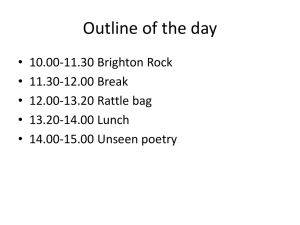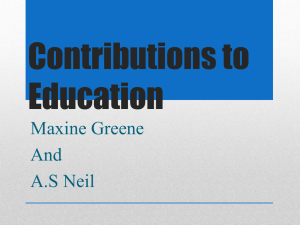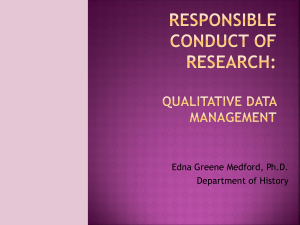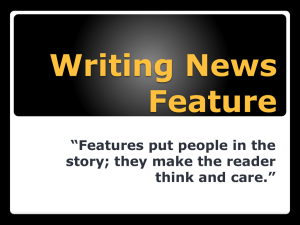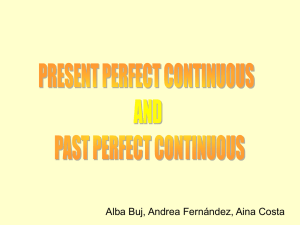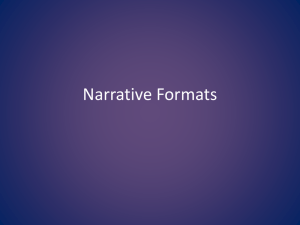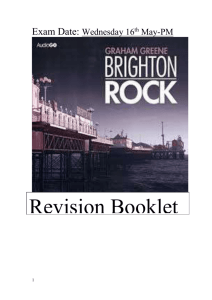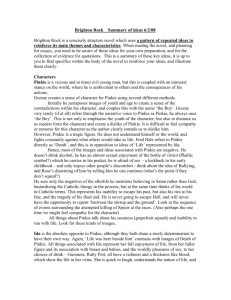Essay writing guide a level
advertisement
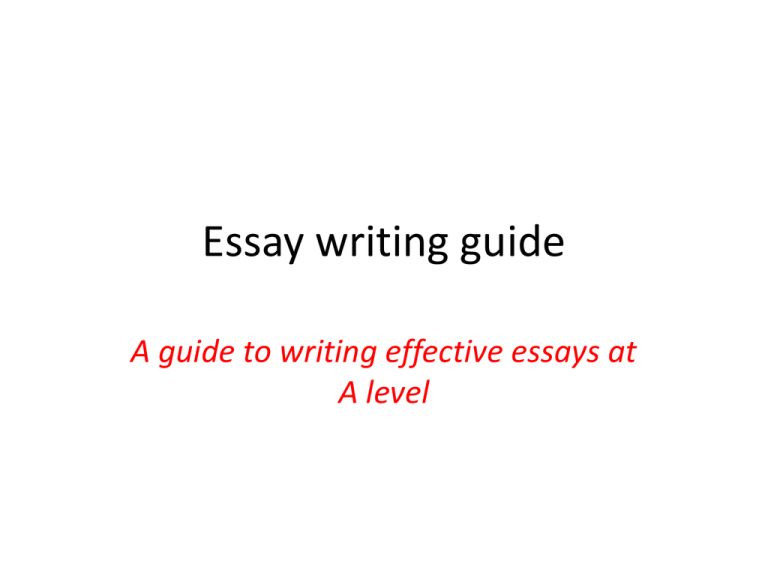
Essay writing guide A guide to writing effective essays at A level 7 Stages of success • • • • • • • Stage 1: The question Stage 2: The argument Stage 3: The ideas Stage 4: The structure Stage 5: The evidence Stage 6: The analysis Stage 7: Proof read/edit Stage 1: The Question • Question the question: • • • • What are the key words? What view does it suggest? What does it assume? What are the problems with it? How is trust presented in the novel? How is trust presented? Character Plot Symbolism/imagery Etc… Is trust the most important theme in the novel? Can you challenge whether trust is a theme? Why present the theme of trust? How does it link into the larger message of the text? Your turn! Your turn! Your turn! Stage 2- The argument • Responding to the question. 1 sentence. Example- Model • Both Greene and Burgess challenge the concept of truth and, while many of the characters in Brighton Rock and A Clockwork Orange feel the have an understanding of the ‘truth’ of life, these are often contradictory and conflicting ideas, leading the reader to question the very nature of how we define what is true. Example Stage 2- The argument • Develop your sentence into a paragraph drawing on information from the text(s). Both Greene and Burgess challenge the concept of truth and, while many of the characters in Brighton Rock and A Clockwork Orange feel the have an understanding of the ‘truth’ of life, these are often contradictory and conflicting ideas, leading the reader to question the very nature of how we define what is true. • How do we support this? Where is the evidence in the text? • This becomes your introduction. Stage 2- The argument • Both Greene and Burgess challenge the concept of truth and, while many of the characters in Brighton Rock and A Clockwork Orange feel they have an understanding of the ‘truth’ of life, these are often contradictory and conflicting ideas, leading the reader to question the very nature of how we define what is true. In Brighton Rock Greene presents us with two vastly opposing perspectives in the characters of Pinkie and Ida, with Rose struggling to find the ‘truth’ from these conflicting ideologies. Greene raises more questions than he answers in his presentation of concepts such as religion and morality, emphasising the subjectivity of these concepts and, ultimately, denying the characters, and the reader, any real truth in the novel. This is echoed in A Clockwork Orange where Burgess’ presentation of Alex initially implies a clear moral perspective, however the moral questions of state control and loss of individual freedom, lead the reader into murky territory where a clear moral view cannot be defined. Essentially, both authors offer us conflicting and contradictory perspectives which challenge accepted moral, religious and philosophical views, leading the reader on a search for truth without offering a definite answer. Stage 3- The Plan • Look at your introduction. Where can you find evidence to support your claims? • These are the key points of the essay. Example- Intro identify • Both Greene and Burgess challenge the concept of truth and, while many of the characters in Brighton Rock and A Clockwork Orange feel they have an understanding of the ‘truth’ of life, these are often contradictory and conflicting ideas, leading the reader to question the very nature of how we define what is true. In Brighton Rock, Greene presents us with two vastly opposing perspectives in the characters of Pinkie and Ida, with Rose struggling to find the ‘truth’ from these conflicting ideologies. Greene raises more questions than he answers in his presentation of concepts such as religion and morality, emphasising the subjectivity of these concepts and, ultimately, denying the characters, and the reader, any real truth in the novel. This is echoed in A Clockwork Orange where Burgess’ presentation of Alex initially implies a clear moral perspective, however the moral questions of state control and loss of individual freedom, lead the reader into murky territory where a clear moral view cannot be defined. Essentially, both authors offer us conflicting and contradictory perspectives which challenge accepted moral, religious and philosophical views, leading the reader on a search for truth without offering a definite answer. Plan Different perspectives Truth in religion Plan Both characters and reader denied truth Truth in morality Develop Different perspectives: Pinkie/Ida/Alex Rose trying to make sense at the end Narrative perspective- Brighton at the start Truth in religion: CatholicismPinkie/Rose Alex and Chaplain Plan Both characters and reader denied truth: Rose’s ending Alex’s ending Character’s misunderstand themselves Narrative form (focalisation and 1st person= no secure narrative view. Truth in morality Right and wrong Pinkie vs. Ida Alex vs. State Step 4- The structure • Intro- Respond to the question and reference • • the things you will explore in the text to support your argument. Main body- Analyse 4-5 aspects of the text in detail to support your response to the question. You must show an understanding of the text while justifying your argument. Conclusion- Summarise your points and answer the question, linking it into what you believe is the overall message of the text/s. Step 5- Finding evidence • GOOD EVIDENCE• Allows you to analyse a range of language features • Links to other key points in the text • Reflects key themes • Supports your argument. • BAD EVIDENCE• Supports your argument BAD EVIDENCE! • “But you believe don’t you… you think its true?” • Rose wants to believe in religion & in Pinkie. She is searching for the truth. GOOD EVIDENCE! ’. • Meaning is subjective. Pinkie does not view the concept of murder with the same moral perspective as others. The comparison to two extremely mundane common nouns (‘box’ and ‘collar’) shows the lack of emotional attachment from Pinkie’s perspective. Greene chooses the word Giraffe to create an element of the unknown, as Pinkie’s working class roots would mean that he would be unlikely to have come into contact with anything as exotic as a giraffe. In doing so he also hints at Pinkie’s inability to realise what we would consider the ‘true meaning of the word ‘murder. Greene uses this passage to emphasise the point of the difficultly of finding the truth when people interpret things in different ways. The subjective nature of abstract verbs such as ‘murder’ contrasts to the different ways characters define large moral concepts such as good and evil and right and wrong in the text. Greene is asking the reader to question their accepted view of life’s certainties, especially when it comes to morally challenging ideas. Step 6- The analysis • AOs Analysis pyramid (plus tail)- for each point in your plan… Point- What part of the text addresses the question? 1.Quote 2. Language analysis (AO2) 3. Structural analysis (AO2) 4. Formal analysis (AO2) 5. Thematic analysis (AO2) 6. Contextual/comparative analysis (AO3/4) 7. Link back to question (AO1) 1. 2. 3. 4. 5. 6. 7. 8. Point- What element of the text are you using to support your argument/response to the question? Quote- a ‘good’ quotation to back up your point. Language analysis- analyse key words, images, symbols, connotations etc. Structural analysis- Where does it come in the book? How does it relate to other events? What is its larger significance in the plot? Formal analysis- What elements of the genre are present? How do they link to meaning? How are the conventions of the form (novel, poetry, drama) used? E.g. narrative perspective, parallel narrative, manipulation of narrative and chronological time. Thematic analysis- How does the analysis you’ve done so far link to the key ideas of the novel? How does it achieve the writer’s purpose? Contextual/comparative analysis- How does the writer’s purpose reflect the concerns of the time? How does the reader’s response reflect their own cultural and historical moment? How is it similar/different to other texts? Why? Link back to question- How does everything you’ve said justify your original point and how does it link to the question asked? Context/links (if applicable) Meaning- Link back to question Form structure language point ’. Stage 7- Proof read and edit your work Basic literacy (spelling, punctuation etc.)? Capital letters for names of characters/author’s name etc.? Paragraphing? Does each sentence make sense? Have you said what you actually wanted to say? Have you included analysis linking to the Aos? Stage 7- Proof read and edit- Literacy • Green gets us too question the whether we can ever know the truth in his description of the setting initially, he describes brighton effectively using lots of positive language, making it seem like a perfect holiday town; “Silverpoint sparkled on the pier”. However, later he gives a different impression that suggests it might not be quite so perfect. It says determined gaiety, implies that they are forcing themselves to enjoy it and are not really having fun this makes us think that perhaps it is just a front and the people isn’t as carefree as they a pear. By giving diferent perspectives greene makes it is hard to form a clear impression of what Brighton is really like. This challenges the reader to think about weather they can ever be sure on anything.. Step 7- Proof read and edit- Quality • How can we turn this from a C into and A? • Greene gets us to question whether we can ever know the truth in his description of the setting. Initially, he describes Brighton effectively using lots of positive language, making it seem like a perfect holiday town; “Silverpoint sparkled on the pier”. However, later he gives a different impression that suggests it might not be quite so perfect. It says ‘determined gaiety’, which implies that they are forcing themselves to enjoy it and are not really having fun. This makes us think that perhaps it is just a front and people aren’t as carefree as they appear. By giving different perspectives Greene makes it is hard to form a clear impression of what Brighton is really like. This challenges the reader to think about whether they can ever be sure on anything. Greene’s use of changing narrative perspective problematises the idea that we can ever ascertain the ‘truth’. The initial impression of Brighton is one of a busy yet beautiful setting, in which you imagine only good things could occur; ‘The holiday crowd. They came in from Victoria every five minutes…’ The opening of the novel focuses on the superficial aspects of the popular holiday location: ‘Silverpoint sparkled on the pier...’, ‘houses ran away in the west like a pale Victorian watercolour’. This imagery enforces the idea of a spotless, perfect vacation where thousands of people go for the purpose of innocent fun and entertainment – it is from a holiday-goers perspective. However, it is suggested that this is merely a surface appearance and nothing is revealed in any depth. The image of a ‘Victorian watercolour’ implies that this is a false, artificial image, not reflecting reality but merely a romanticised depiction. Greene then juxtaposes this description of Brighton with one from a wholly different perspective. Hale seems to have negative views on the crowd; ‘It uncurled past him, like a twisted wire, two by two’. The use of the simile ‘like a twisted wire’ makes the crowd seem aggressive, coiled in rage and metallic and hard like a wire. It is also suggested that the picture book perfect image of Brighton that we are given in the first few paragraphs of the book does not ring true with the crowd. The narrative describes them as having ‘determined gaiety’, as if they were determined to have fun here, despite being on ‘crowded carriages’ and the fact they ‘wait in queues for lunch’. In doing this Greene suggests that, despite the appearance of careless perfection, the grim reality of life is inescapable. By focalising the narrative from different perspectives Greene denies us a fixed impression on Brighton. The question of what is real and what is merely perspective is raised but not answered by the narrative style. Where are the AOs? Greene’s use of changing narrative perspective problematises the idea that we can ever ascertain the ‘truth’. The initial impression of Brighton is one of a busy yet beautiful setting, in which you imagine only good things could occur; ‘The holiday crowd. They came in from Victoria every five minutes…’ The opening of the novel focuses on the superficial aspects of the popular holiday location: ‘Silverpoint sparkled on the pier...’, ‘houses ran away in the west like a pale Victorian watercolour’. This imagery enforces the idea of a spotless, perfect vacation where thousands of people go for the purpose of innocent fun and entertainment – it is from a holiday-goers perspective. However, it is suggested that this is merely a surface appearance and nothing is revealed in any depth. The image of a ‘Victorian watercolour’ implies that this is a false, artificial image, not reflecting reality but merely a romanticised depiction Where are the AOs? Greene then juxtaposes this description of Brighton with one from a wholly different perspective. Hale seems to have negative views on the crowd; ‘It uncurled past him, like a twisted wire, two by two’. The use of the simile ‘like a twisted wire’ makes the crowd seem aggressive, coiled in rage and metallic and hard like a wire. It is also suggested that the picture book perfect image of Brighton that we are given in the first few paragraphs of the book does not ring true with the crowd. The narrative describes them as having ‘determined gaiety’, as if they were determined to have fun here, despite being on ‘crowded carriages’ and the fact they ‘wait in queues for lunch’. In doing this Greene suggests that, despite the appearance of careless perfection, the grim reality of life is inescapable. By focalising the narrative from different perspectives Greene denies us a fixed impression on Brighton. The question of what is real or true and what is merely perspective is raised but not answered by the narrative style. Essay writing checklist? • What are the keys to a successful A level essay? Targets- What are you going to do differently in your next essay?

